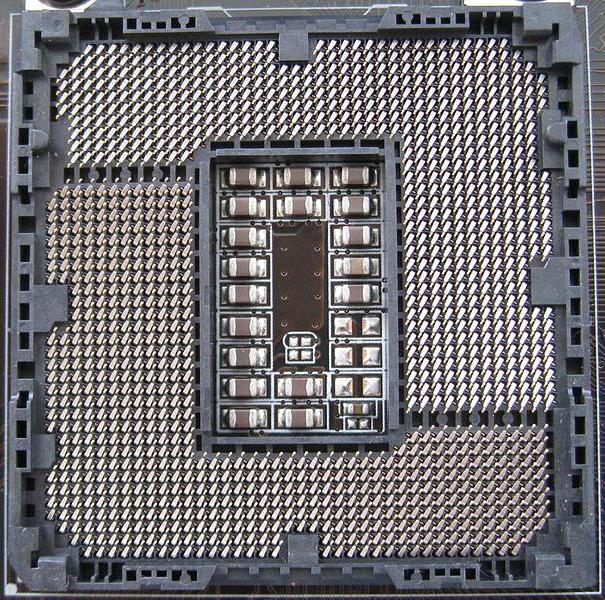
"Socket" 1155 was presented at the very beginning of 2011. Its appearance marked cardinal changes in the sphere of processor solutions, which led to a significant increase in the speed of the computer.

In the first decade of 2011, sales startedupdated computing platform from Intel, which was based on the Socket 1155 socket. The first significant innovation was the updating of the computing part of the processor devices, which allowed to get a higher level of PC performance. The second important point is the implementation of the CPU and the integrated graphics processor on a single semiconductor chip with a tolerance of 32 nm.
Although the previous generation of chips wasone body, but consisted of 2 crystals. One of them is the computational units with the built-in "north bridge", manufactured using 32 nm technology, and the second one - the graphic accelerator with the technological process at 45 nm.
Another important difference from the predecessorsis the support of sets of system logic of such important and faster interfaces as USB 3.0 and SATA 3.0. In 2012, for LGA 1155 was released an updated line of CPUs already the third generation based on the same architecture. From their predecessors they were distinguished by an improved technological process (22 nm) and a modified thermal paste under the metal cover.
The last nuance significantly worsened the acceleratingpotential of this family of CPUs. In 2013, the Socket 1155 replaced the even more efficient and high-speed Socket 1150. And after 3 more years, the light saw another processor socket from Intel - LGA 1151. If the choice is Socket 1155 or 1150, it's best to choose from the position of speed of the second of them. And in comparison with Socket 1151 all its predecessors fade and significantly lose by technical parameters and speed.

Two generations of chipsets could be based onsuch a computer component for LGA 1155, as motherboard. "Socket" 1155 was aimed at using sets of system logic related to the 6th or 7th series. The first one was released for the 2nd generation CPU. After the BIOS update, it was also possible to install the 3rd generation of chips. Well, the 7-series was initially universal and allowed to install both generations of CPUs. Conditionally, the chipsets in this case could be divided as follows:
The initial level was presented onlyone product - H61. Only 16 GB of RAM and the lack of any overclocking of the computational part made this product ideal for office PCs. Also in such a PC it was possible to install a maximum of 4 storage devices with a SATA interface.
The average level included B65, P67 and Q67 for the 6thseries and B75, Q75, Q77 and H77 - for the 7th. In this case, the amount of RAM was already doubled and was 32 GB. Also, the number of ports for drives was increased.
To assemble the most productive PCs,designed P67 (do not support the built-in graphics in the CPU) and Z68 in the 6th series of logic sets and Z75 and Z77 in the seventh. Products based on the data of the system logic sets had a much higher level of functionality and allowed almost any PC component (RAM, CPU or even graphics accelerator) to be dispersed.

Socket 1155 was aimed at installing chips2-nd or 3-rd generation based on the best semiconductor architecture for the CPU - Core. Accordingly, the most productive chips in this case were marked with 2XXX for the first one and 3XXX for the second one. This is i3, and i5, and i7.
You could also install the ruler chipsCeleron, or Pentium in LGA 1155. The Socket, processors and other components of the computer system were unified, and it was possible to install the most productive chip or, on the contrary, to put the lowest-performing CPU in the lowest price on the entry-level motherboard.
Of course, today is no longer worth itthe dilemma is Socket 1155 or 1150. The current solution for 2016 is the LGA 1151 processor socket, which is aimed at installing chips based on the most advanced architecture for the Core 6th generation CPU. It is on him and you need to pay attention when building a new system unit. Processor same connectors LGA 1150 and more ancient LGA 1155 slowly come down from the historical arena. But their performance is quite enough to solve any task to date, so it's too early to think about upgrading this PC. Pay attention to components makes sense only if you need a repair of the system unit, which is based exactly on this computing platform.

For 2011, the Socket 1155 was a breakthroughdecision. He laid the foundation, on the basis of which more recent and productive central processors were developed. Including Core chips with the marking 6XXX (that is, the CPU based on this architecture is already the 6th generation). Otherwise, this platform goes quietly into oblivion. Its accessories can still be found on the shelves of stores. But there is no special reason to buy them when building a new PC. There are more topical products that are based on LGA 1151, and it is on them that you need to pay attention when assembling or bundling a new personal computer.
</ p>